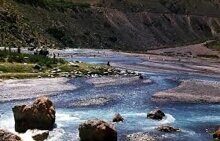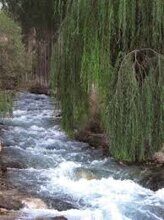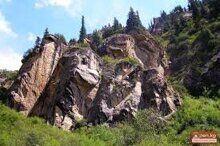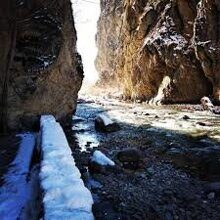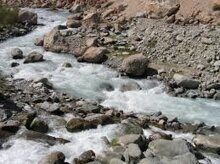Shakhimardan
 Shakhimardan is one of the most beautiful places in Uzbekistan. The city is located 55 km south of Fergana and located at an altitude of 1500 m above sea level, among the mountains of the Alai Range. Shakhimardan is washed on both sides by the mountain rivers Ok-su and Kok-su, which unite into one river - Shakhimardan-sai. It is interesting that on the way from Fergana you need to cross the Shakhimardan-say river seven times to get to the village itself.
Shakhimardan is one of the most beautiful places in Uzbekistan. The city is located 55 km south of Fergana and located at an altitude of 1500 m above sea level, among the mountains of the Alai Range. Shakhimardan is washed on both sides by the mountain rivers Ok-su and Kok-su, which unite into one river - Shakhimardan-sai. It is interesting that on the way from Fergana you need to cross the Shakhimardan-say river seven times to get to the village itself.
In the 1930s, as a result of the exchange of territories between Uzbekistan and Kyrgyzstan, Shakhimardan became part of Uzbekistan, forming an enclave - a kind of small island surrounded by the lands of the Batken region of Kyrgyzstan; the distance to the “main” territory of Uzbekistan is about 17 km.
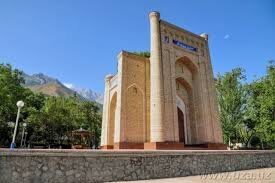 The history of Shahimardan is largely associated with the name of Hazrat Ali, the fourth caliph, son-in-law of the Prophet Muhammad. There is a version that during Hazrat Ali’s stay in Central Asia, he visited the village of Shakhimardan, and one of his possible seven graves is located in this village, which practically cannot be proven or denied. Translated from Persian, “Shakhimardan” means “Lord of People,” which correlates with the name of Hazrat Ali.
The history of Shahimardan is largely associated with the name of Hazrat Ali, the fourth caliph, son-in-law of the Prophet Muhammad. There is a version that during Hazrat Ali’s stay in Central Asia, he visited the village of Shakhimardan, and one of his possible seven graves is located in this village, which practically cannot be proven or denied. Translated from Persian, “Shakhimardan” means “Lord of People,” which correlates with the name of Hazrat Ali.
In the 20s, in the center of Shakhimardan there was a mosque and mausoleum of Hazrat Ali, where believers came to pray. However, during the era of persecution of religion, the Soviet authorities destroyed Ali's mausoleum. And only after Uzbekistan gained independence in 1993, the mausoleum of Hazrat Ali was rebuilt on the same site and retained its external shape. Shakhimardan for some time was called Hamzaabad, in honor of the poet and founder of Uzbek drama Hamza Hakim-zade Niyazi. In the 60s, a museum and mausoleum were built in his honor.
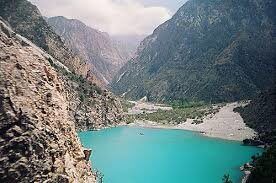 Seven kilometers southeast of Shakhimardan is Lake Kulikubbon or Blue Lake. It was formed after a series of earthquakes in 1766. The lake is located at an altitude of 1724 meters above sea level. The length is 170 meters, width - 60 meters, depth - from 5 to 10 meters. In summer, the water temperature rises to 10-15 degrees Celsius. A two-kilometer cable car leads to the lake. This corner of nature is the most beloved for both local residents and tourists.
Seven kilometers southeast of Shakhimardan is Lake Kulikubbon or Blue Lake. It was formed after a series of earthquakes in 1766. The lake is located at an altitude of 1724 meters above sea level. The length is 170 meters, width - 60 meters, depth - from 5 to 10 meters. In summer, the water temperature rises to 10-15 degrees Celsius. A two-kilometer cable car leads to the lake. This corner of nature is the most beloved for both local residents and tourists.
In terms of frequency of reference in various contexts, only a few concepts can compare with the term "ecotourism"; the Variety of existing definitions is illustrated by the following examples.
• "Ecotourism is nature-based tourism that includes environmental education and awareness programs and is carried out in accordance with the principles of environmental sustainability"
«Nature-based tourism that involves education and interpretation of the natural environment and is managed to be ecologically sustainable» Commonwealth Department of Tourism (1992), Australian National Ecotourism Strategy, Canberra
«Purposeful travel to natural areas to understand the culture and natural history of the environment, taking are not to alter the integrity of the ecosystem, while producing opportunities that make the conservation of natural resources beneficial to local people» Ecotourism Society, 1994
«A sustainable form of natural resource based tourism that focuses primarily on expenencinq and learning about nature, and which is ethically managed to be low impact, non-consumptive and locally orientated (control, benefits and scale) It typically occurs in natural areas and should contribute to the conservation and preservation of such areas » Fennell, D (1999) Ecotounsm Routledge
«Ecotounsm can contribute to both conservation and development and involves, as a minimum, positive synergistic relationships between tourism, biodiversity and local people facilitated by appropriate management» Ross, S and Wall, G (1999), «Evaluating Ecotounsm the Case of North Sulawesi, Indonesia», Tourism Management, Vol 20, No 6, pp 673-682
«That kind of tourism which is (a) based on relatively undisturbed natural areas, (b) non-damaging, non-degrading, (c) a direct contributor to the continued protection and management of the natural areas used, (d) subject to an adequate and appropriate management regime» Valentine, P (1993) Ecotourism and Nature Conservation A definition with some recent developments in Micronesia Tourism Management, Vol 14, No 2,pp 107-115
«The planned practice of tourism in which the enjoyment of nature and learning about living beings and their relationship with the environment are brought together, it is an activity which does not result in a deterioration of the environment and which promotes and supports the conservation of natural resources, thereby producing economic benefits which reach most social strata of the population in such a way that a sustainable horizontal development is achieved. Moreover, real ecotourism promotes justice for people and for nature». Evans-Pritchard, D. and Salazar, S. (1992), «What is Ecotourism?»Eco-lnstitute of Costa Rica and ULACIT.
«Ecotourism consists of three core criteria: the primary attraction is nature-based (such as flora and fauna, geological features), with cultural features constituting a secondary component; the emphasis is on the study and/or appreciation of the resource in its own right; and the activities of the tourists and other participants are benign with respect to their impact upon the physical and cultural environment of the destination. Ecotourism ... should be coherent with the notion of sustainable tourism by adhering to the carrying capacities of the destination and being acceptable to, and supportive of, host communities». Weaver, D.B. (1999), «Magnitude of Ecotourism in Costa Rica and Kenya», Annals of Tourism Research, Vol. 26, No. 4, pp.792-816.
Of the many definitions of ecotourism, the following are the most widely used in the literature.
The International Union for Conservation of Nature (IUCN) defines ecotourism as "a journey with responsibility to the environment through relatively undisturbed natural areas for the purpose of exploring and enjoying nature and cultural attractions that promotes conservation, has a "soft" impact on the environment, and ensures the active socio-economic participation and benefits of local residents" (Ceballos-Lascurain, 1993a).
A similar definition is given by the ecotourism Society: "Ecotourism is responsible travel to natural areas that promotes nature conservation and improves the well-being of the local population."
The definition is also known:"...tourism, which includes trips to places with relatively untouched nature, in order to get an idea of the natural and cultural-ethnographic features of the area, which does not violate the integrity of ecosystems and creates such economic conditions that the protection of nature and natural resources becomes profitable for the local population." There is a simpler definition: "Ecotourism is nature tourism that promotes nature conservation" (world wildlife Fund, Boo, 1990).
Thus, the distinctive features of ecotourism are that it encourages and satisfies the desire to communicate with nature, prevents negative impacts on nature and culture, and encourages tour operators and tourists to promote nature conservation and socio-economic development.
Thus, ecotourism is an important component of sustainable development of natural territories. It is easy to see that most definitions of ecotourism are based on either the goal of achieving sustainability or the means to achieve this goal, whether it is "minimizing negative impacts on the natural and cultural environment", "enhancing economic returns for the benefit of nature protection" or environmental education. Therefore, CREG Lindberg (Lind-berg et al., 1998) suggests using a simpler and more general conceptual definition:
"Ecotourism is sustainable and nature-oriented tourism and recreation." Sustainability in tourism implies a positive overall balance of the environmental, socio-cultural and economic impacts of tourism, as well as the positive impact of visitors on each other. Thus, those types of tourism activities that have the highest overall positive effect in terms of ecology, economy and social development are more sustainable.



